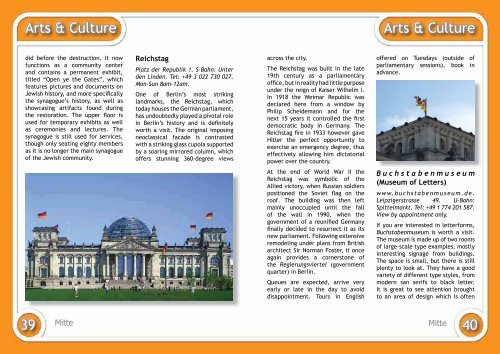Create successful ePaper yourself
Turn your PDF publications into a flip-book with our unique Google optimized e-Paper software.
Arts & Culture Arts & Culture<br />
did before the destruction. It now<br />
functions as a community center<br />
and contains a permanent exhibit,<br />
titled “Open ye the Gates”, which<br />
features pictures and documents on<br />
Jewish history, and more specifi cally<br />
the synagogue’s history, as well as<br />
showcasing artifacts found during<br />
the restoration. The upper fl oor is<br />
used for temporary exhibits as well<br />
as ceremonies and lectures. The<br />
synagogue is still used for services,<br />
though only seating eighty members<br />
as it is no longer the main synagogue<br />
of the Jewish community.<br />
Reichstag<br />
Platz der Republik 1. S-Bahn: Unter<br />
den Linden. Tel: +49 3 022 730 027.<br />
Mon-Sun 8am-12am.<br />
One of <strong>Berlin</strong>’s most striking<br />
landmarks, the Reichstag, which<br />
today houses the German parliament,<br />
has undoubtedly played a pivotal role<br />
in <strong>Berlin</strong>’s history and is defi nitely<br />
worth a visit. The original imposing<br />
neoclassical facade is contrasted<br />
with a striking glass cupola supported<br />
by a soaring mirrored column, which<br />
offers stunning 360-degree views<br />
across the city.<br />
The Reichstag was built in the late<br />
19th century as a parliamentary<br />
offi ce, but in reality had little purpose<br />
under the reign of Kaiser Wilhelm I.<br />
In 1918 the Weimar Republic was<br />
declared here from a window by<br />
Philip Scheidemann and for the<br />
next 15 years it controlled the fi rst<br />
democratic body in Germany. The<br />
Reichstag fi re in 1933 however gave<br />
Hitler the perfect opportunity to<br />
exercise an emergency degree, thus<br />
effectively allowing him dictatorial<br />
power over the country.<br />
At the end of World War II the<br />
Reichstag was symbolic of the<br />
Allied victory, when Russian soldiers<br />
positioned the Soviet fl ag on the<br />
roof. The building was then left<br />
mainly unoccupied until the fall<br />
of the wall in 1990, when the<br />
government of a reunifi ed Germany<br />
fi nally decided to resurrect it as its<br />
new parliament. Following extensive<br />
remodeling under plans from British<br />
architect Sir Norman Foster, it once<br />
again provides a cornerstone of<br />
the Regierungsviertel (government<br />
quarter) in <strong>Berlin</strong>.<br />
Queues are expected, arrive very<br />
early or late in the day to avoid<br />
disappointment. Tours in English<br />
offered on Tuesdays (outside of<br />
parliamentary sessions), book in<br />
advance.<br />
B u c h s t a b e n m u s e u m<br />
(Museum of Letters)<br />
w w w. b u c h s t a b e n m u s e u m . d e .<br />
Leipzigerstrasse 49. U-Bahn:<br />
Spittelmarkt. Tel: +49 1 774 201 587.<br />
View by appointment only.<br />
If you are interested in letterforms,<br />
Buchstabenmuseum is worth a visit.<br />
The museum is made up of two rooms<br />
of large-scale type examples, mostly<br />
interesting signage from buildings.<br />
The space is small, but there is still<br />
plenty to look at. They have a good<br />
variety of different type styles, from<br />
modern san serifs to black letter.<br />
It is great to see attention brought<br />
to an area of design which is often<br />
39 Mitte Mitte 40


